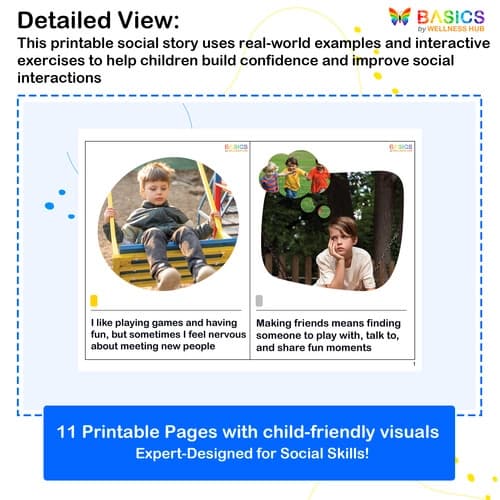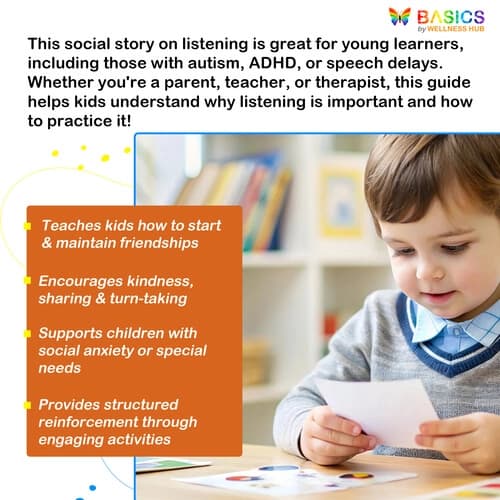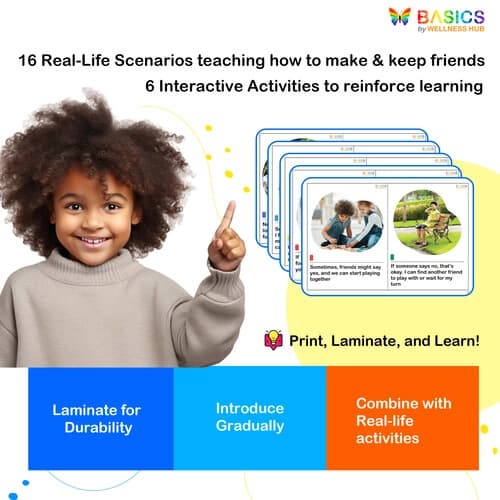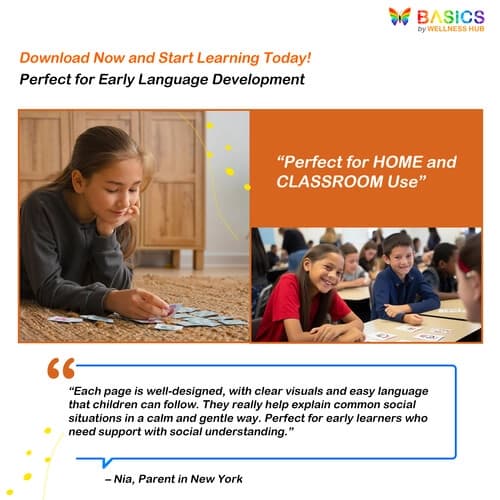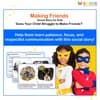
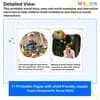
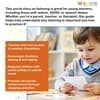
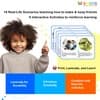
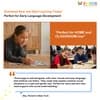
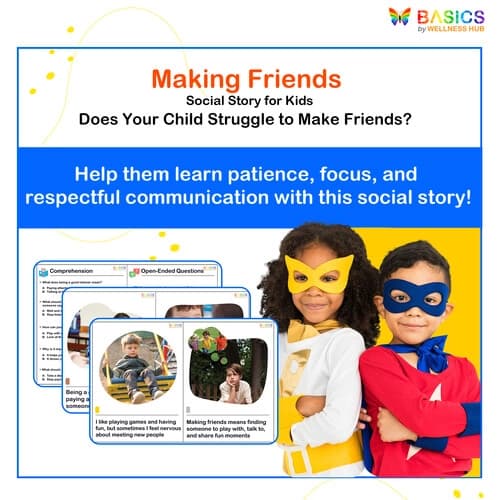
Making Friends – Social Story for Building Social Skills
₹80
₹160
50% off
0 (0 ratings)
Grade Levels
Pre-K - Grade 3 (Ages 4-9)
Content Overview
Format: Printable PDF, Total Pages: 11, Features: 16 real-life scenarios, engaging illustrations, 6 interactive activities
Categories
Pages from the Resource
Help children learn how to make friends, start conversations, and be a good friend with this engaging social story. Using real-life examples and interactive activities, kids will build confidence in making and maintaining friendships. Perfect for kids with autism, ADHD, and social-emotional learning needs.
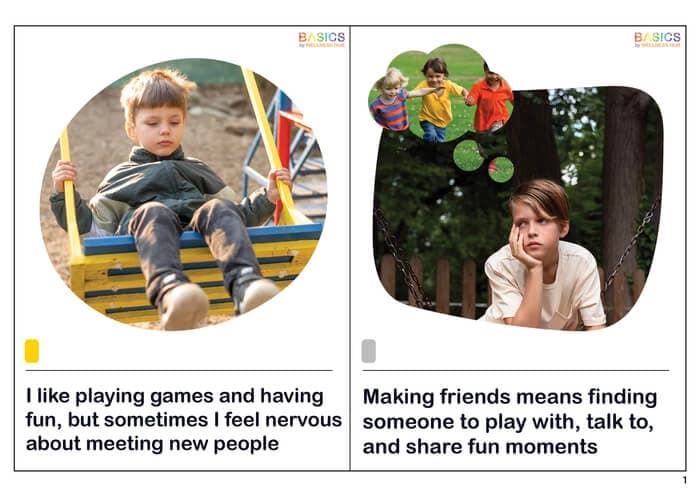
Page 1

Page 2
What Users Say
0
0 ratings
5
0+
4
0+
3
0+
2
0+
1
0+
5 Stars
Product is Good to use.
1 year ago
Varsha Parent
Similar Products
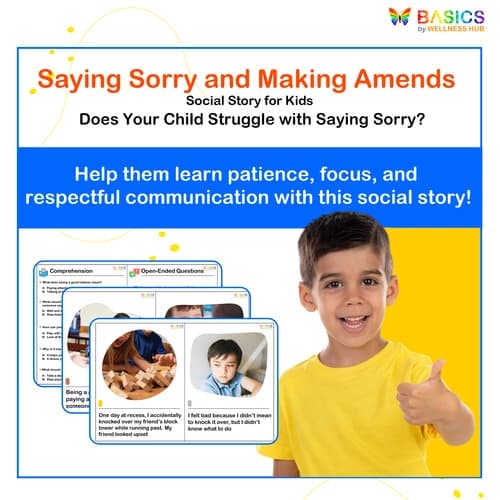
Saying Sorry and Making Amends – Social Story for Kids
₹ 80.00
₹ 160.00
50% off
5.0 (42 ratings)
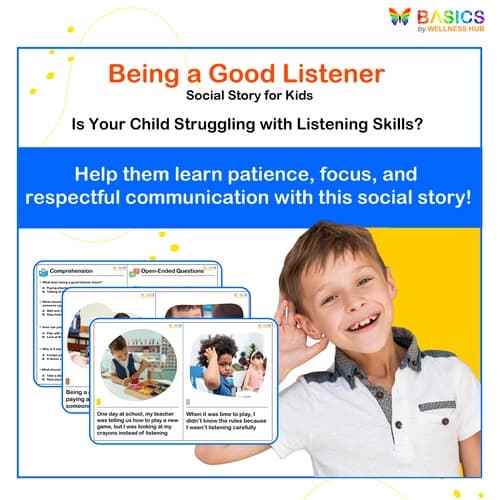
Being a Good Listener – Social Story for Kids’ Communication Skills
₹ 80.00
₹ 160.00
50% off
4.8 (44 ratings)

Inviting Someone to Play – Social Story for Kids’ Social Skills
₹ 80.00
₹ 160.00
50% off
4.8 (50 ratings)
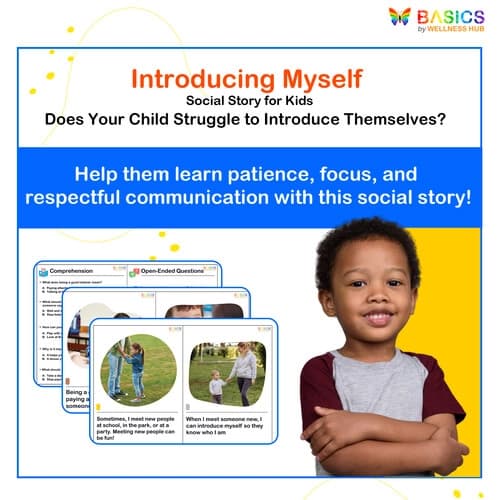
Introducing Myself – Free Social Story for Kids’ Communication Skills
₹ 80.00
₹ 160.00
50% off
4.8 (60 ratings)
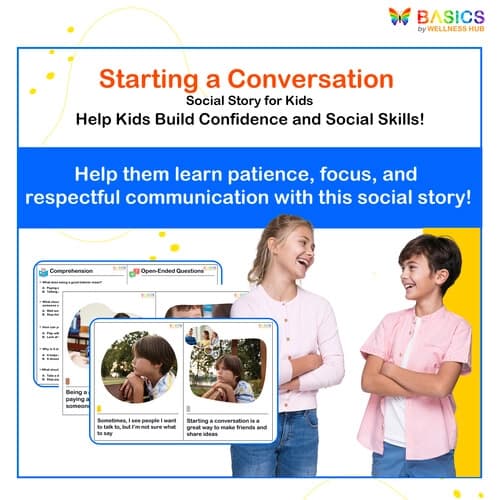
Starting Conversations – Social Story for Kids' Communication Skills
₹ 80.00
₹ 160.00
50% off
5.0 (56 ratings)
About the Product
Introduction
Making friends is an essential part of a child's social and emotional development. However, for many children—especially those with autism, ADHD, or social communication challenges—learning how to start conversations, share, take turns, and understand social cues can be difficult.
This printable social story provides step-by-step guidance on how to build and maintain friendships. It introduces real-life scenarios that help children understand the key elements of friendship, social confidence, and positive interactions.
This resource is designed to:
✔ Help children understand what friendship means and why it’s important.
✔ Teach essential social skills like introducing oneself, taking turns, listening, and showing kindness.
✔ Encourage confidence in initiating and maintaining friendships.
Through first-person storytelling, engaging illustrations, and interactive activities, this social story helps children develop positive social behaviors in a structured, easy-to-understand format.
This resource is ideal for:
✔ Preschoolers and early learners who are developing social awareness and communication skills.
✔ Children with autism, ADHD, or social-emotional difficulties who need structured guidance on making friends.
✔ Parents, teachers, and therapists looking for a tool to teach friendship-building in a supportive way.
By reinforcing positive social behaviors and emotional awareness, this social story empowers children to connect with others and build meaningful friendships.
Product Details
- Format: Printable PDF
- Total Pages: 11
- Segments: 16 real-life scenarios teaching friendship-building and social confidence.
- Features:
✔ Engaging illustrations to support understanding.
✔ First-person storytelling to help children relate to the lesson.
✔ 6 interactive activities that reinforce social skills.
✔ Simple, child-friendly language for easy comprehension.
✔ Scenarios include: introducing yourself, joining a group, turn-taking, listening, showing kindness, and handling conflicts.
This structured social story is a valuable tool for teaching social-emotional skills, self-awareness, and relationship-building to young children.
Educational Benefits
This social story provides a structured and engaging way to teach children how to develop friendships and social confidence.
1. Teaches Social Awareness & Friendship Skills
✔ Helps children understand what friendship is and why it’s important.
✔ Provides clear explanations of how to make and maintain friendships.
✔ Reinforces key social behaviors such as listening, turn-taking, and sharing.
2. Encourages Positive Peer Interactions
Instead of feeling anxious or unsure, children learn how to:
✔ Introduce themselves and start conversations.
✔ Join a group and interact in a friendly way.
✔ Take turns and share during playtime.
✔ Show kindness, respect, and empathy toward others.
3. Supports Social-Emotional Learning (SEL) & Special Needs
✔ Designed for children with autism, ADHD, and social communication difficulties.
✔ Uses clear, structured lessons to help children understand social expectations.
4. Reinforces Learning with Interactive Activities
✔ Helps children practice and apply friendship-building techniques.
✔ Includes hands-on learning opportunities through discussions, role-playing, and drawing activities.
This step-by-step approach ensures that children internalize and apply these friendship skills, leading to better peer relationships and increased social confidence.
Instructions for Use
This social story should be used consistently to help children develop stronger social skills and confidence in making friends.
1. Read & Discuss the Story
- Read the story aloud with your child or student.
- Pause at key moments to ask reflection questions:
"How do you introduce yourself to someone new?"
"What should you do if you want to join a game?"
"How can you show kindness to a friend?"
2. Use Real-Life Examples & Visual Cues
- Identify real-life moments when a child has an opportunity to make a friend and gently remind them of the social story.
- Use visual reminders like a "Friendship Skills" chart in classrooms, homes, and therapy rooms.
- Model friendly and respectful social interactions to reinforce learning.
3. Engage in Interactive Activities
- Use the six included activities to reinforce key strategies:
✔ Role-Playing Social Scenarios – Practicing introductions and friendly conversations.
✔ "Good Friends vs. Not-So-Good Friends" Sorting Activity – Identifying positive vs. negative friendship behaviors.
✔ Social Scenario Matching – Recognizing ways to respond in different friendship situations.
✔ Empathy & Kindness Chart – Teaching how to show kindness in friendships.
✔ Comprehension Questions – Checking understanding of the story.
✔ Creative Activity – Drawing or role-playing friendship-building skills.
4. Reinforce Positive Social Behaviors Daily
- Model friendly behaviors in different situations.
- Praise positive social interactions when a child makes an effort to connect with others:
"Great job introducing yourself to your new friend!"
"I love how you asked your friend if they wanted to play!"
Activities Using the Resource
This printable social story includes engaging, hands-on activities that help children understand how to initiate and maintain friendships while practicing key social skills like turn-taking, active listening, and showing kindness.
1. "Good Friends vs. Not-So-Good Friends" Sorting Activity
Objective: Help children differentiate between positive and negative friendship behaviors.
✔ Materials: Printable sorting cards with different friendship behaviors.
✔ How to Play:
- Show different behaviors related to friendship (e.g., "Sharing a toy" vs. "Not listening when a friend speaks").
- Have the child sort them into two categories:
✔ Good Friend Choices (e.g., helping a friend, using kind words).
✔ Not-So-Good Friend Choices (e.g., interrupting, excluding someone from a game). - Discuss why some behaviors help build friendships and why others may hurt feelings.
2. "How Do I Start a Friendship?" Discussion Cards
Objective: Teach children how to initiate and maintain friendships through social interaction.
✔ Materials: Printable discussion prompt cards.
✔ How to Play:
- Read a scenario aloud (e.g., "You see someone playing alone at recess. What can you say to start a conversation?").
- Encourage the child to think and respond with a friendly way to interact.
- Reinforce positive social behaviors through guided discussion.
3. "Role-Playing Social Scenarios" Exercise
Objective: Teach children how to start conversations, join in play, and resolve conflicts in friendships.
✔ Materials: No materials needed, just role-playing.
✔ How to Play:
- Call out different friendship situations (e.g., "Someone asks to play with you," "You want to join a game," "A friend is feeling sad").
- Have the child practice responding appropriately by:
✔ Introducing themselves with confidence.
✔ Asking to join a game or conversation.
✔ Using kind words and active listening skills.
✔ Problem-solving when a friend is upset. - Reinforce positive choices with praise and encouragement.
4. "What Makes a Good Friend?" Chart
Objective: Help children identify qualities of a good friend.
✔ Materials: Printable "Friendship Qualities" chart.
✔ How to Play:
- Show different friendship traits (e.g., "Being kind," "Listening," "Taking turns").
- Ask the child, “What makes a good friend?”
- Have them point to or circle qualities they believe make friendships strong.
- Encourage them to practice these qualities with others.
5. "Friendship Journal" Creative Activity
Objective: Help children reflect on their friendships and positive social experiences.
✔ Materials: Paper and crayons.
✔ How to Play:
- Have the child draw a picture of a time they made a new friend.
- Ask them to describe what they said and did to start the friendship.
- Reinforce positive social behaviors and friendly interactions.
FAQs
Q1: Who is this social story designed for?
A1: This resource is designed for children ages 4–9 who need help learning how to make and maintain friendships. It is especially helpful for:
✔ Kids who feel shy or anxious about making new friends.
✔ Children with autism, ADHD, and social communication difficulties.
✔ Parents, teachers, and therapists looking for structured tools to teach friendship-building skills.
Q2: How do I use this social story effectively?
A2: ✔ Read the story regularly – Repetition helps children internalize the lesson.
✔ Ask open-ended questions – "What can you do if you want to make a friend?"
✔ Use the interactive activities – Reinforce learning through role-playing and sorting games.
✔ Praise good social interactions – Reinforce self-confidence with positive reinforcement.
Q3: Can this be used in therapy sessions?
A3: Yes! This printable social story is an excellent tool for:
✔ Speech therapists, occupational therapists, behavioral therapists, and special educators.
✔ Social-emotional learning (SEL) lessons in therapy and classroom settings.
Q4: Does this resource include interactive activities?
A4: Yes! Along with the 16 real-life segments, this story includes 6 structured activities that help children practice and reinforce positive social behaviors.
Q5: Is this a printable or a physical book?
A5: This is a printable PDF that you can download instantly. It is not a physical book, but you can print it or use it digitally on a tablet.
Q6: Can this be used in a classroom setting?
A6: Absolutely! Teachers can:
✔ Use it during social-emotional learning (SEL) lessons.
✔ Read it aloud to small groups to discuss friendship skills.
✔ Use role-play activities to help students practice friendly social interactions.
Q7: How can I reinforce these lessons at home?
A7: ✔ Model friendly behavior – Show your child how to introduce themselves and be a kind friend.
✔ Praise positive interactions – Reinforce when they take turns, listen, and engage positively with others.
✔ Use reminders – Visual cue cards, posters, and charts can help reinforce friendship-building skills.
Usage Rights and Restrictions
To ensure ethical use of this resource, please follow these guidelines:
✔ Allowed:
Personal use by parents, educators, and therapists.
✅ Printing multiple copies for your classroom or therapy sessions.
✅ Using digitally on a tablet or computer.
Not Allowed:
❌ Sharing, distributing, or reselling this resource in any format.
❌ Uploading the PDF to online platforms or third-party websites.
❌ Modifying the content for commercial purposes.
For bulk licensing or school-wide access, please contact us for special permissions.
Conclusion
"Making Friends – Social Story for Building Social Skills" is an engaging and structured way to help children:
✔ Learn how to make and keep friends.
✔ Develop confidence in social situations.
✔ Understand the importance of kindness, sharing, and listening.
By using real-life scenarios, engaging illustrations, and structured activities, this printable social story helps children gain confidence in building and maintaining friendships.
✅ Instant download – Start using it today!
Perfect for home, school, and therapy sessions.
